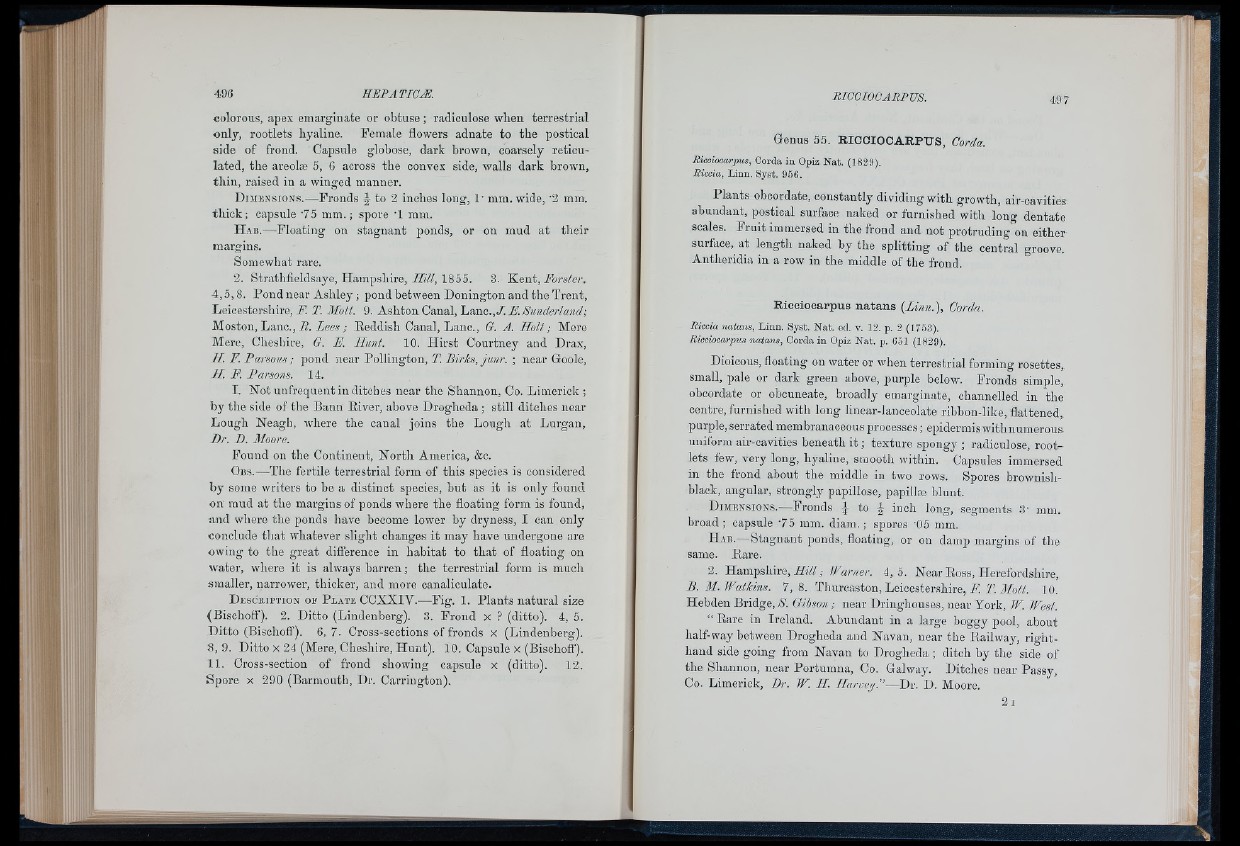
■colorous, apex emarginate or obtuse ; radiculose when terrestrial
■only, rootlets hyaline. Female flowers adnate to the postical
side of frond. Capsule globose, dark brown, coarsely reticulated,
the areolæ 5, G across the convex side, walls dark brown,
thin, raised in a winged manner.
D i .\iensions.— Fronds ^ to 2 inches long, 1' mm. wide, '2 mm.
thick; capsule 75 m m .; spore T mm.
H a b .—Floating on stagnant ponds, or on mud at their
margins.
Somewhat rare.
2. Strathfieldsaye, Hampshire,//«//, 1855. 3. Kent, iL r/e r.
4,5,8. Pond near Ashley ; pond between Donington and the Trent,
Leicestershire, F. T. Moil. 9. Ashton Canal, hima.,!. E. Sunderland;
Moston, Lane., ii*. Lees ; Reddish Canal, Lano., G. A. Holt; Mere
Mere, Cheshire, G. E. Hunt. 10. Hirst Courtney and Drax,
![. F. Parsons ; pond near Pollington, T. Bir/cs, jimr. ; near Goole,
H. F. Parsons. 14.
I. Not unfrequent in ditches near the Shannon, Co. Limerick ;
by the side of the Bann Eiver, above Drogheda ; still ditches near
Lough Neagli, where the canal joins the Lough at Lurgan,
Er. D. Moore.
Found on the Continent, North America, &o.
O b s .— The fertile terrestrial form of this species is considered
by some writers to be a distinct species, but as it is only found
on mud at the margins of ponds where the floating form is found,
and where the ponds have become lower by dryness, I can only
conclude that whatever slight changes it may have undergone are
owing to the great difference in habitat to th.at of floating on
water, where it is always barren ; the terrestrial form is much
smaller, narrower, thicker, and more canaliculate.
D escription oe P late CCXXIV.—Fig. 1. Plants natural size
(Bisoholf). 2. Ditto (Lindenherg). 3. Frond x ? (ditto). 4, 5.
Ditto (Bischoff). 6, 7. Cross-sections of fronds x (Lindenherg).
8, 9. Ditto X 24 (Mere, Cheshire, Hunt). 10. Capsule x (Bischofi).
11. Cross-section of frond showing capsule x (ditto). 12.
Spore X 290 (Barmouth, Dr. Carrington).
Genus 55. RICCIOCARPUS, Corda.
IS, Corda in Opiz Nat. (1829).
Riccia, Linn. Syst. 956.
Plants obcordate, constantly dividing with growth, air-cavities
abundant, postical surface naked or furnished with long dentate
scales. Fruit immersed in the frond and not protruding on either
surface, at length naked by the splitting of the central groove.
Antheridia in a row in the middle of the frond.
Ricoiooarpus n a tan s {Linn.), Corda.
Piccia natans, Linn, Syst. Nat. ed. v. 12. p. 2 (175,3).
Ricciocarpus natans, Corda in Opiz Nat. p. 651 (1829).
Dioicous, floating on water or when terrestrial forming rosettes,
small, pale or dark green above, purple below. Fronds simple,
obcordate or obcuneate, broadly emarginate, channelled in "the
centre, furnished with long linear-lanceolate ribbon-like, flattened,
purple, serrated membranaceous processes ; epidermis with numerous
uniform air-cavities beneath it ; texture spongy ; radiculose, rootlets
few, very long, hyaline, smooth within. Capsules immersed
in the frond about the middle in two rows. Spores brownish-
black, angular, strongly papillose, papillæ blunt.
D imensions.—Fronds g to ^ inch long, segments 3' mm.
broad ; capsule 75 mm. diam. ; spores ’05 mm.
H.-vb.—Stagnant ponds, floating, or on damp margins of the
same. Eare.
2. Hampshire, ÆÆ; IVarner. 4,5. Near Eoss, Herefordshire,
B. M. Watkins. 7, 8. Thuroaston, Leicestershire, H. T. Mott. 10.
Hebden Bridge, N Grfiyo« ; near Dringhouses, near York, W. West.
“ Eare in Ireland. Abundant in a large boggy pool, about
half-way between Drogheda and Navan, near the Railway, right-
hand side going from Navan to Drogheda ; ditch by the side of
the Shannon, near Portumna, Co. Galway. Ditches near Passy,
Co. Limerick, Dr. W. H. llarcey.”—Dr. D. Moore.
2 i